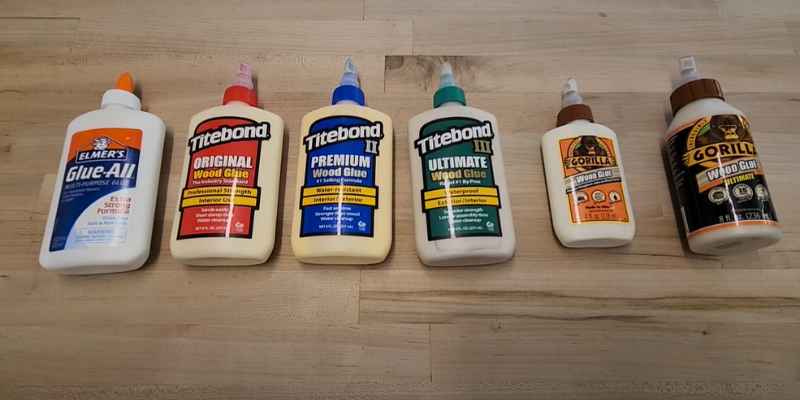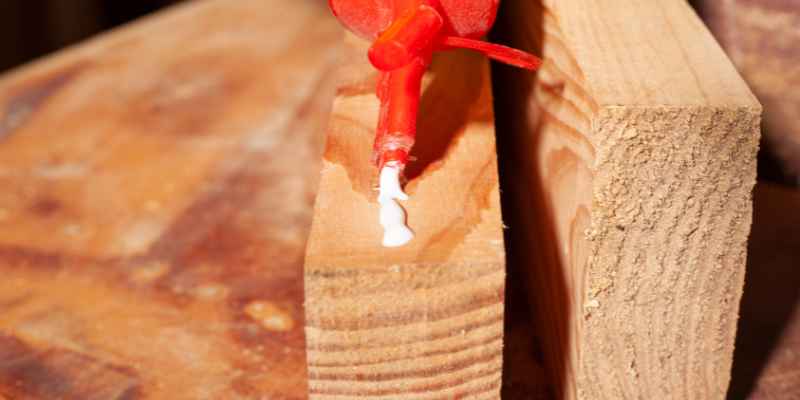Titebond and Elmer’s Wood Glue are two popular wood glues. Here’s a concise answer to the Titebond Vs Elmers Wood Glue question: Titebond and Elmer’s Wood Glue are both high-quality wood glues, but Titebond is known for its superior strength and fast-drying properties, while Elmer’s Wood Glue is more versatile and suitable for a wide range of woodworking projects.
Wood glue is an essential tool for any woodworking project, providing a strong and reliable bond between wood pieces. Among the many options available in the market, two leading brands stand out: Titebond and Elmer’s Wood Glue. This article aims to compare and contrast these two wood glues to help you make an informed decision based on your specific needs.
Whether you’re a professional woodworker or a DIY enthusiast, understanding the differences between Titebond and Elmer’s Wood Glue is crucial to ensure the success of your woodworking projects. From strength and drying time to versatility and ease of use, we will explore all the aspects that set these two wood glues apart, providing you with valuable insights before making your final choice.
Composition And Formulation
When it comes to woodworking projects, one crucial component is the type of wood glue used. Two popular options in the market are Titebond and Elmer’s Wood Glue. These brands have gained trust and popularity among woodworkers due to their high-quality products. In this article, we will explore the composition and formulation of Titebond Wood Glue and Elmer’s Wood Glue to help you make an informed decision for your woodworking needs.
Titebond Wood Glue Composition
Titebond Wood Glue is known for its exceptional bond strength and versatility. The composition of Titebond Wood Glue plays a significant role in its performance. Here’s a breakdown of the key components:
- Polymer Resin: The primary ingredient in Titebond Wood Glue is a water-based polymer resin. This resin provides excellent adhesion and allows the glue to penetrate deep into the wood fibers.
- Fillers: Titebond Wood Glue also contains fillers, which help enhance the glue’s gap-filling capabilities. These fillers help to bridge gaps between uneven surfaces and ensure a strong bond.
- Water: Titebond Wood Glue has a high water content, which aids in its ability to be easily spread and absorbed by the wood.
- Modifiers and Additives: Titebond Wood Glue may also include modifiers and additives to improve specific properties such as drying time, heat resistance, and water resistance.
Elmer’s Wood Glue Composition
Elmer’s Wood Glue is another reliable option for woodworking projects, known for its strong bond and user-friendly nature. Let’s delve into the composition of Elmer’s Wood Glue:
- PVA (Polyvinyl Acetate): The main component of Elmer’s Wood Glue is Polyvinyl Acetate, a type of thermoplastic polymer. PVA is widely used in various applications due to its adhesive properties and flexibility.
- Water: Similar to Titebond Wood Glue, Elmer’s Wood Glue has a significant water content that allows for easy application and absorption into the wood.
- Modifiers and Stabilizers: Elmer’s Wood Glue may also contain modifiers and stabilizers to enhance specific characteristics such as drying time and resistance to moisture.
- Preservatives: Elmer’s Wood Glue is formulated with preservatives to prevent the growth of mold and ensure the glue’s longevity.
Both Titebond Wood Glue and Elmer’s Wood Glue offer reliable adhesion and have a similar water-based composition. However, the specific formulations and inclusion of additives in each brand contribute to their unique characteristics and performance. It’s essential to consider the composition and formulation of wood glues to choose the most suitable option for your woodworking projects.

Strength And Bonding Performance
When it comes to woodworking projects, choosing the right wood glue is essential for ensuring strong and reliable joints. Two popular brands that offer excellent bonding properties are Titebond and Elmer’s Wood Glue. In this article, we will compare the strength and bonding performance of these two renowned wood glues, helping you to make an informed decision.
Titebond Wood Glue Strength
Titebond Wood Glue is known for its exceptional strength and reliability. It is specifically formulated to provide a strong bond on various wood types, including hardwoods, softwoods, and porous materials. This wood glue offers a high bond strength, ensuring that your wood joints will stay securely in place.
One of the key factors that contribute to Titebond’s strength is its advanced adhesive formula. This formula allows the glue to penetrate the wood fibers, creating a durable bond that holds up well under stress. Whether you are working on small crafts or large furniture pieces, Titebond Wood Glue provides the strength you need for long-lasting results.
Elmer’s Wood Glue Strength
Elmer’s Wood Glue, on the other hand, is also recognized for its strength and reliability. It is a popular choice among woodworkers and DIY enthusiasts for its ability to create strong bonds between wood surfaces. This wood glue offers a secure hold, ensuring that your woodworking projects remain intact.
Elmers Wood Glue is formulated with a special resin that provides an excellent bond on a variety of wood materials. Whether you’re joining solid wood, plywood, MDF, or particleboard, Elmer’s Wood Glue delivers a sturdy connection that withstands the test of time. Its strength makes it suitable for both interior and exterior applications, giving you peace of mind knowing that your project will stay strong regardless of the environmental conditions.
Bonding Performance Comparison
When comparing the bonding performance of Titebond and Elmer’s Wood Glue, both brands offer impressive results. However, Titebond Wood Glue is often preferred by professional woodworkers due to its exceptional strength and versatility.
To help you understand the differences more clearly, let’s take a look at a comparison table:
| Feature | Titebond Wood Glue | Elmer’s Wood Glue |
|---|---|---|
| Bond Strength | High | Strong |
| Wood Compatibility | Hardwoods, softwoods, porous materials | All wood types |
| Weather Resistance | Indoor and outdoor use | Indoor use |
| Application | Easy to use, spreads evenly | Easy to use, dries quickly |
Both Titebond and Elmer’s Wood Glue offer excellent bonding performance, but Titebond’s versatility and superior bond strength make it the top choice for many woodworking projects. Whether you’re building furniture, cabinets, or small crafts, Titebond Wood Glue can provide the strong and reliable bond you need.
Drying Time And Clamping Requirements
When it comes to woodworking projects, choosing the right wood glue is crucial for achieving sturdy and long-lasting bonds. Two popular brands, Titebond and Elmer’s, are often pitted against each other. In this section, we will compare the drying time and clamping requirements of Titebond glue and Elmer’s glue.
Titebond Glue Drying Time
Titebond glue, renowned for its strength and reliability, offers various options with different drying times. The drying time of Titebond glues can vary depending on factors such as temperature, humidity, and the type of Titebond glue used. Here’s a breakdown of the typical drying times for some common variants:
- Titebond Original Wood Glue: This fast-drying glue typically sets within 30 minutes, allowing you to move on with your project swiftly.
- Titebond II Premium Wood Glue: With an extended drying time of approximately 1-2 hours, this glue provides ample working time for intricate woodworking projects.
- Titebond III Ultimate Wood Glue: If you require extra time for assembly, Titebond III offers an extended drying time of around 8-10 hours, ensuring you have enough time for complex projects.
Elmer’s Glue Drying Time
Elmer’s wood glue, another widely recognized brand, also offers different options with varying drying times. Let’s take a look at their typical drying times:
- Elmer’s Interior Carpenter’s Wood Glue: This glue is a fast-drying option that typically sets within 20-30 minutes, allowing you to proceed with your projects promptly.
- Elmer’s ProBond Advanced: With a slightly longer drying time of about 1-2 hours, this glue provides adequate working time for intricate woodworking tasks.
- Elmer’s Max Wood Glue: Offering a quick initial tack and a relatively short drying time of around 30-45 minutes, this glue enables efficient project completion.
Clamping Requirements
Both Titebond and Elmer’s wood glues require clamping to ensure proper bonding. Here are the clamping recommendations for each brand:
| Titebond Glue | Elmer’s Glue |
|---|---|
| Titebond Original Wood Glue: Requires clamping for 30 minutes to 1 hour. | Elmer’s Interior Carpenter’s Wood Glue: Requires clamping for 20-30 minutes. |
| Titebond II Premium Wood Glue: Requires clamping for 1-2 hours. | Elmer’s ProBond Advanced: Requires clamping for 1-2 hours. |
| Titebond III Ultimate Wood Glue: Requires clamping for at least 8 hours. | Elmer’s Max Wood Glue: Requires clamping for 30-45 minutes. |
Keep in mind that these clamping times are general recommendations, and it’s always advisable to consult the specific product instructions for optimal results.
Versatility And Compatibility
When it comes to woodworking projects, having the right adhesive is essential. Two popular choices in the market are Titebond and Elmer’s wood glue. Both offer strong bonding capabilities, but they have their unique features that make them suitable for different applications. In this section, we will explore the versatility and compatibility of these wood glues.
Titebond Wood Glue Applications
Titebond wood glue is a trusted adhesive among woodworking enthusiasts and professionals. It is renowned for its superior holding power, making it suitable for a wide range of applications. Whether you are constructing furniture, cabinets, or even musical instruments, Titebond wood glue delivers consistent and durable bonds. Its fast setting time allows for quicker project completion, while its exceptional sandability ensures seamless finishing.
Elmer’s Wood Glue Applications
Elmer’s wood glue, on the other hand, is another popular choice known for its versatility. It is perfect for both indoor and outdoor applications, making it an excellent choice for various woodworking projects. From basic repairs to intricate crafts, Elmer’s wood glue provides a reliable bond. Whether you are a beginner or an experienced woodworker, Elmer’s wood glue is easy to use, ensuring that your projects will stay together for years to come.
Compatibility With Different Wood Types
When choosing a wood glue, compatibility with different wood types is crucial. Titebond wood glue is designed to bond with a wide variety of woods, including hardwoods, softwoods, and even engineered woods. Its strong bond ensures that your wood pieces stay securely joined, regardless of the type of wood you are working with. Elmer’s wood glue, too, offers excellent compatibility with various wood types, making it a versatile adhesive suitable for different woodworking projects.
In conclusion, both Titebond and Elmer’s wood glue offer exceptional versatility and compatibility for woodworking applications. Whether you need a strong bond for furniture construction, repairs, or crafts, these wood glues deliver reliable results. Their compatibility with different wood types further expands their applications, allowing you to tackle various projects with confidence.

Frequently Asked Questions Of Titebond Vs Elmers Wood Glue
Is Elmers Glue As Good As Wood Glue?
Elmer’s glue and wood glue serve different purposes. Elmer’s glue is suitable for general crafts and light-duty applications, while wood glue offers stronger bonding specifically for wood projects.
What Is The Strongest Glue For Wood To Wood?
The strongest glue for wood to wood is epoxy adhesive. It provides a strong, permanent bond that withstands heavy loads and is resistant to moisture and temperature changes. Epoxy adhesive forms a durable joint that is ideal for woodworking projects and furniture repairs.
Is Titebond A Good Wood Glue?
Yes, Titebond is a reliable and high-quality wood glue that is commonly used by professionals and DIY enthusiasts. It provides strong bonding, has a long shelf life, and is suitable for various woodworking projects.
Is Gorilla Glue As Good As Titebond?
Gorilla Glue and Titebond are both strong adhesives, but they have different properties. Gorilla Glue is waterproof and expands as it cures, whereas Titebond is waterproof once dry and does not expand. The choice depends on the specific project needs.
Conclusion
Ultimately, when comparing Titebond and Elmers wood glue, both products have their advantages and disadvantages. Titebond offers a stronger bond and is more durable, making it a better choice for heavy-duty applications. On the other hand, Elmers wood glue is more affordable and easier to work with for simpler woodworking projects.
It’s important to consider your specific needs and preferences before making a decision.


